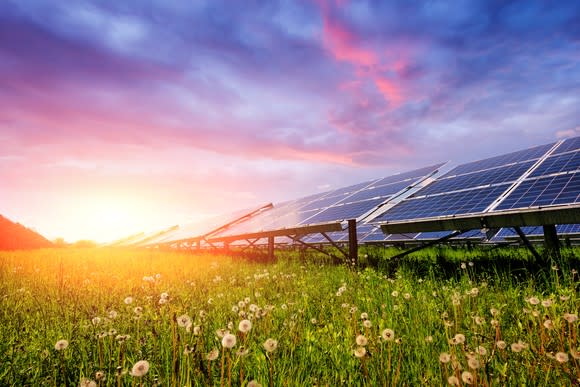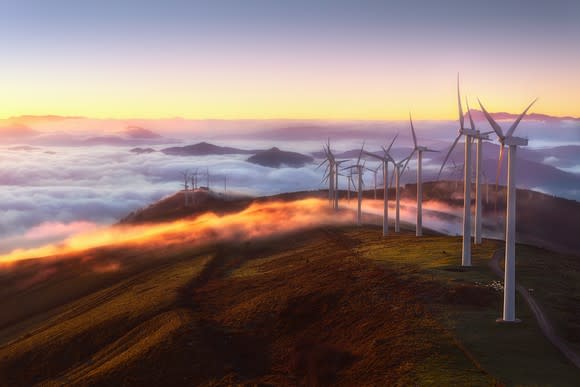This High-Yield Stock Has a Plan to Capture a Sizable Slice of This $10 Trillion Market
"We are in the early stages of a transformation of the global power grid, moving from fossil fuels to renewables," wrote Sachin Shah, the CEO of Brookfield Renewable Partners (NYSE: BEP), in the company's second-quarter letter to investors. He continued by noting that "this will require significant investment over multiple decades." The overall size of the market, in Shah's view, is more than $10 trillion to replace the nonrenewable capacity in the company's core markets with wind and solar. It's even larger when factoring in energy demand growth and the electrification of transportation.
It's an opportunity that Brookfield Renewable is working to capture by taking a multipronged approach to building and buying renewable-energy assets across several technologies. That strategy will give the company the power to grow its 6.7%-yielding distribution to investors at a 5% to 9% annual pace in the years ahead, which sets it up to generate total annual returns in the 12% to 15% range.

Image source: Getty Images.
Building out an expandable global platform
Brookfield Renewable has invested about $3.5 billion over the past five years to build a global platform of renewable-energy technologies. It spent roughly two-thirds of that capital on three transactions. In 2014, it bought a portfolio of wind farms in Europe that had the capacity to generate 321 MW of power at the time -- representing 15% of Ireland's wind power -- as well as 125 MW of projects under construction and another 300 MW in development. That transaction gave it a platform on which to build a leading renewable-power business in Europe.
The company followed that up in 2016 by acquiring a stake in a renewable-power company in Colombia, which owned 3,032 MW of mainly hydroelectric assets -- enough to supply 20% of the country's power -- as well as a 3,800 MW development portfolio. Finally, in the last year, it has bought TerraForm Global as well as a controlling stake in TerraForm Power (NASDAQ: TERP). Those transactions broadened its global platform while adding solar power to its portfolio. TerraForm not only came with a large installed asset base of 3,600 MW, but it owned the right of first offer to buy 500 MW of renewable assets from developers as part of previous acquisitions.

Image source: Getty Images.
Investing to build a brighter future
With a large platform in place, Brookfield Renewable believes it can invest $700 million to $800 million per year into expanding its renewable footprint. One use of that capital will be to build out about 1,000 MW of renewable generating capacity in the coming years. The company has an extensive pipeline to pull from and believes it can build new wind farms in Europe, Colombia, and Brazil, small hydroelectric facilities in Brazil, and distributed solar (rooftop) installations in North America and China.
The company already has several facilities under construction, including wind farms in Europe, hydro projects in Brazil, and a pumped storage facility in the U.S. that should come online over the next few years. In addition to that, its parent, Brookfield Asset Management (NYSE: BAM), signed a joint venture with one of the largest logistics companies in China to add rooftop solar on industrial and commercial buildings in the country. They aim to develop 330 MW of projects over the next three years and see the potential to install 1 GW of rooftop solar in the future, which is enough to power 750,000 homes.
Meanwhile, Brookfield's investment in TerraForm Power has helped stabilized that company's financial situation so that it can resume its expansion. That company recently bought a large wind and solar company in Spain that Brookfield Renewable helped finance, which gave it an expandable platform in Western Europe. TerraForm has gone on to secure a few more small deals and is working with developers to grow its pipeline. In addition to making acquisitions, TerraForm is also looking into expanding the renewable-power generating capacity of some of its existing sites by installing larger, more powerful wind turbines.
A plan to profit
Brookfield Renewable invested several billion dollars in recent years to build a diversified renewable-power platform that stretches across the globe. The company's aim going forward is to spend $700 million to $800 million per year to expand its portfolio through both developing new renewable-power projects and buying them from other developers. That multipronged approach should enable the company to grow its cash flow at a 6% to 11% annual rate, which should support 5% to 9% yearly growth in its high-yielding distribution. That growing income stream has the potential to enrich its investors over the long term.
More From The Motley Fool
Matthew DiLallo owns shares of Brookfield Asset Management, Brookfield Renewable Energy Partners, and TerraForm Power. The Motley Fool has no position in any of the stocks mentioned. The Motley Fool has a disclosure policy.

 Yahoo Finance
Yahoo Finance 